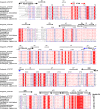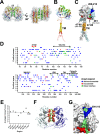Mapping the protein binding site of the (pro)renin receptor using in silico 3D structural analysis
- PMID: 36481966
- PMCID: PMC10073018
- DOI: 10.1038/s41440-022-01094-w
Mapping the protein binding site of the (pro)renin receptor using in silico 3D structural analysis
Erratum in
-
Publisher Correction: Mapping the protein binding site of the (pro)renin receptor using in silico 3D structural analysis.Hypertens Res. 2023 Apr;46(4):1067-1068. doi: 10.1038/s41440-022-01139-0. Hypertens Res. 2023. PMID: 36529849 Free PMC article. No abstract available.
Abstract
We have previously reported that monoclonal antibodies against the (pro)renin receptor [(P)RR] can reduce the Wnt/β-catenin-dependent development of pancreatic ductal adenocarcinoma (PDAC), the most common pancreatic cancer. Antibodies against two (P)RR regions (residues 47-60 and 200-213) located in the extracellular domain (ECD) reduced the proliferation of human PDAC cells in vitro. Although these regions probably participate in the activation of Wnt/β-catenin signaling, their functional significance remains unclear. Moreover, the (P)RR ECD is predicted to possess an intrinsically disordered region (IDR), which allows multiple protein interactions because of its conformational flexibility. In this study, we investigated the significance of the two regions and the IDR by in silico 3D structural analysis using the AlphaFold2 program and evolutionary sequence conservation profile. The model showed that ECD adopted a folded domain (residues 17-269) and had an IDR (residues 270-296). The two regions mapped onto the structural model formed a continuous surface patch comprising evolutionarily conserved hydrophobic residues. The homodimeric structure predicted by AlphaFold2 showed that full-length (P)RR comprising the ECD, single-span transmembrane, and cytoplasmic domains formed a twofold symmetric dimer via the ECD, which explains the experimentally proven homodimerization. The dimer model possessed two hand-shaped grooves with residues 47-60 and 200-213 in their palms and the IDR as their fingers. Based on these findings, we propose that the IDR-containing hydrophobic grooves act as a binding site for (P)RR and perform multiple functions, including Wnt signaling activation. Antibodies against the (pro)renin receptor residues 47-60 and 200-213 can inhibit pancreatic ductal adenocarcinoma (PDAC) cell proliferation by suppressing Wnt signaling. This study provides 3D structural insights into receptor binding and one-to-many interactions, which underpin the functional versatility of this receptor.
Keywords: (Pro)renin receptor; AlphaFold2; Intrinsically disordered region; Pancreatic ductal adenocarcinoma; Wnt/β-catenin signaling.
© 2022. The Author(s).
Conflict of interest statement
The authors declare no competing interests.
Figures







Similar articles
-
Antiproliferative Effects of Monoclonal Antibodies against (Pro)Renin Receptor in Pancreatic Ductal Adenocarcinoma.Mol Cancer Ther. 2020 Sep;19(9):1844-1855. doi: 10.1158/1535-7163.MCT-19-0228. Epub 2020 Jul 15. Mol Cancer Ther. 2020. PMID: 32669314
-
(Pro)renin receptor is crucial for Wnt/β-catenin-dependent genesis of pancreatic ductal adenocarcinoma.Sci Rep. 2015 Mar 9;5:8854. doi: 10.1038/srep08854. Sci Rep. 2015. PMID: 25747895 Free PMC article.
-
Galectin-4 expression is associated with reduced lymph node metastasis and modulation of Wnt/β-catenin signalling in pancreatic adenocarcinoma.Oncotarget. 2014 Jul 30;5(14):5335-49. doi: 10.18632/oncotarget.2104. Oncotarget. 2014. PMID: 24977327 Free PMC article.
-
Elucidating the Role of Pro-renin Receptors in Pancreatic Ductal Adenocarcinoma Progression: A Novel Therapeutic Target in Cancer Therapy.Curr Cancer Drug Targets. 2024;24(9):881-889. doi: 10.2174/0115680096279288231205105904. Curr Cancer Drug Targets. 2024. PMID: 38279719 Review.
-
(Pro)renin receptor and prorenin: their plausible sites of interaction.Front Biosci (Landmark Ed). 2012 Jan 1;17(1):389-95. doi: 10.2741/3933. Front Biosci (Landmark Ed). 2012. PMID: 22201750 Review.
Cited by
-
Intestinal alkaline phosphatase is a receptor for cholesterol-lowering pentapeptide IIAEK and regulates cholesterol homeostasis in mice.Sci Rep. 2025 Jul 1;15(1):20345. doi: 10.1038/s41598-025-04722-w. Sci Rep. 2025. PMID: 40594298 Free PMC article.
-
Anxiolytic Efficacy of Indirubin: In Vivo Approach Along with Receptor Binding Profiling and Molecular Interaction with GABAergic Pathways.ChemistryOpen. 2025 Feb;14(2):e202400290. doi: 10.1002/open.202400290. Epub 2024 Oct 25. ChemistryOpen. 2025. PMID: 39460441 Free PMC article.
References
MeSH terms
Substances
LinkOut - more resources
Full Text Sources
Medical

